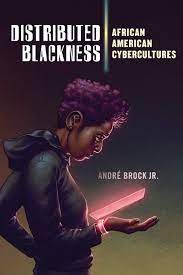 André’s talk was an incredibly dense, rich and through examination of how his concepts of ‘black technoculture’ are useful for seeing how blackness and race are tied into our relationships with technology. It was illuminating from the start, as he confronted specific issues within social media platforms, speaking to the harms that digital culture and algorithms can inflect on black digital practitioners. By specifically looking at how the spread of misinformation can also be linked to algorithmic surveillance through social media, he highlighted how it can polarize using conspiracies, and exacerbate discrimination among minority populations. He is inspired by the work of Simone Browne on surveillance, Safiya Noble on the damaging work that algorithms perform, and Ruha Benjamin on race and technology, as well as Charlton McIlwain on Black Software. His own book Distributed Blackness now adds to this conversation.
André’s talk was an incredibly dense, rich and through examination of how his concepts of ‘black technoculture’ are useful for seeing how blackness and race are tied into our relationships with technology. It was illuminating from the start, as he confronted specific issues within social media platforms, speaking to the harms that digital culture and algorithms can inflect on black digital practitioners. By specifically looking at how the spread of misinformation can also be linked to algorithmic surveillance through social media, he highlighted how it can polarize using conspiracies, and exacerbate discrimination among minority populations. He is inspired by the work of Simone Browne on surveillance, Safiya Noble on the damaging work that algorithms perform, and Ruha Benjamin on race and technology, as well as Charlton McIlwain on Black Software. His own book Distributed Blackness now adds to this conversation.
His position is that despite the gestures towards quick fixes, that online harms cannot be fixed by technology, that they should be considered as part of a socio-cultural examination and solution, because the racism that underlines these practices is institutionalized. In attempting to create such a solution, he asks “what do we gain from understanding racism as infrastructure, and as technoculture”? He describes this as creating an ‘afro-optimistic’ approach, where black folk are not presented as objects of deviance, but as having agency and technical subjectivity.
Brock starts this analysis with the Green Book (NOT the movie) which he describes as the first black-authored network browser, creating a system of infrastructure necessary so that black folk could travel through the South of the US states safely. He also referred to the new HBO show ‘Lovecraft Country’ which explores the “monstrous apparition of the intersectionality of whiteness and technology; that is, where networks are erected ostensibly for freedom, democracy, mobility and commerce, whiteness also sees them as pathways for domination, coercion and violence” regardless of whether this is a real highway or a technical network.
His questions:
1 – are pathology and deviance the only modes of black online? (the answer is no)
2 – how then to understand black digital practice as life-giving?
His focus on American practices particularly is explained because the US has a specific way of understanding the black diaspora – while other black cultures might have a similar trajectory, the US positionality within digital cultures is unique – blackness was created in the US, as described by Toni Morrison as ‘American Africanism’. He also describes blackness as a specific structure of modernity, dating from 1619 when the pilgrims landed in Massachusetts and creating a particular framework, as opposed to white modernity, which pervades all expressive culture from then to now.
One key underlying concept he describes stems from Arnold Pacey’s tripartite nature of technology, where technology includes:
- the artifact (the technical object)
- the practice (the organizational structure) and
- the belief (which is cultural).
Pacey maintains that technologies are most often understood from the first two, and the last, the cultural beliefs that shape our relationship to the technology and how it is used, are often neglected because it is intangible. To try to understand how the three are intertwined therefore, Brock draws on Lyotard’s libidinal economy, which tries to unpack these tensions of political economy that influence our relationship to technology. One other framework Brock refers to is The Western Technocultural Matrix by Joel Dinerstein (2006), which you can see parallels to in Brock’s Distributed Blackness.  The six elements of the Western version are Progress, Religion, Modernity, Whiteness, Masculinity, and The Future. These frames demonstrate how the West is linked to whiteness, and how technology works to the benefit of white supremacy, within capitalism and culture. There were some truly powerful comments by Brock here, referring to how whiteness through technology, particularly social platforms, confers control, while effectively silencing blackness and black voices. This control means that whiteness has a privileged position of “never having to understand how racism affects others.”
The six elements of the Western version are Progress, Religion, Modernity, Whiteness, Masculinity, and The Future. These frames demonstrate how the West is linked to whiteness, and how technology works to the benefit of white supremacy, within capitalism and culture. There were some truly powerful comments by Brock here, referring to how whiteness through technology, particularly social platforms, confers control, while effectively silencing blackness and black voices. This control means that whiteness has a privileged position of “never having to understand how racism affects others.”
In particular, he used the example of the terrible videos of black people like George Floyd being killed by police, and how the videos so quickly went viral. In the US, black folk share content more than any other demographic, so the sharing of the videos gave a high profile and visibility to the videos, from their own communities, not through being shared by hateful white folks with different agendas. Beneath this though, is the ‘weak-tie’ racism that is the second focus of his book. In describing what he means, he refers to the phenomena of black folk experiencing racism without racists – where the algorithms and invisible underlying processes (i.e. coding) exhibit micro-aggressions at scale against black folk, culture and community online. These contribute to the construction of this racism without racists, partly due to the design of social media platforms by the typical silicon valley programmer. This can also described as slow violence.
So how do we fix this? Brock maintains that this is not possible through either technical solutions, institutional curriculum adjustments, increased diversity, or ethical considerations. One way is to consider a moral code of harm reduction, to be enacted during algorithm design, and using such a code to create complex solutions here. The algorithm makes decisions on the types and kinds of posts and advertisements seen in all communities so it is there that change must be enacted. And here André ended.
One really interesting question that came up in the question and answer session following the presentation was regarding how to live with the current system as it is designed. If changes are not enacted, soon, and with widespread effect, how do we exist in such a broken system? The solution suggested is in creating moving objects, constantly adapting to feedback such as is performed in game culture where beta versions of games or programs are released, then edited and amended as they are used. It was acknowledged that one problem inherent in the use of any technology is the convenience factor – where existing, flawed, systems will still continue to be used because they are available and in existence.
I’d like to thank André for his incredibly informative talk. It really was incredibly rich, and leads to a clear and effective call to arms. You can find his book here.

